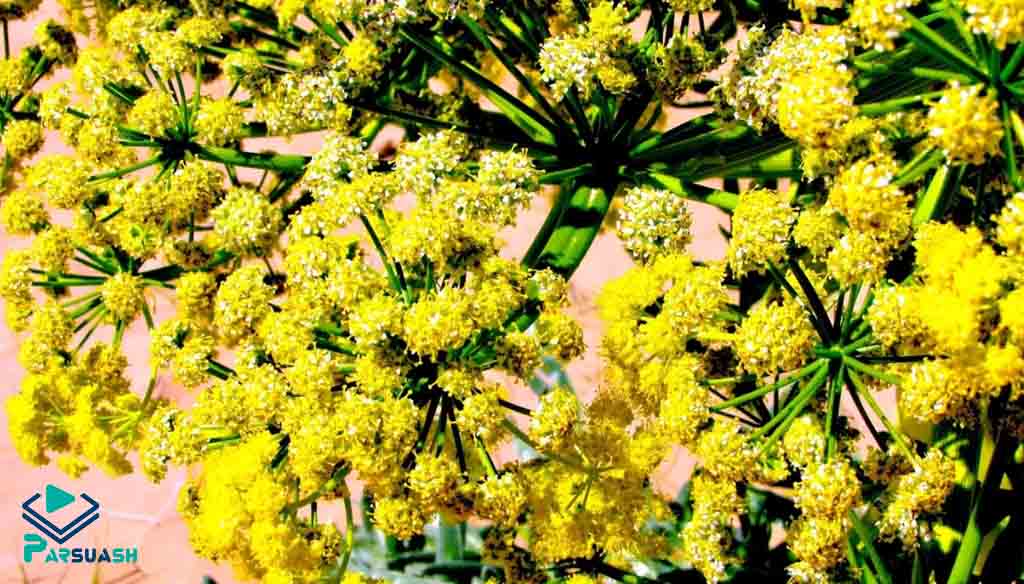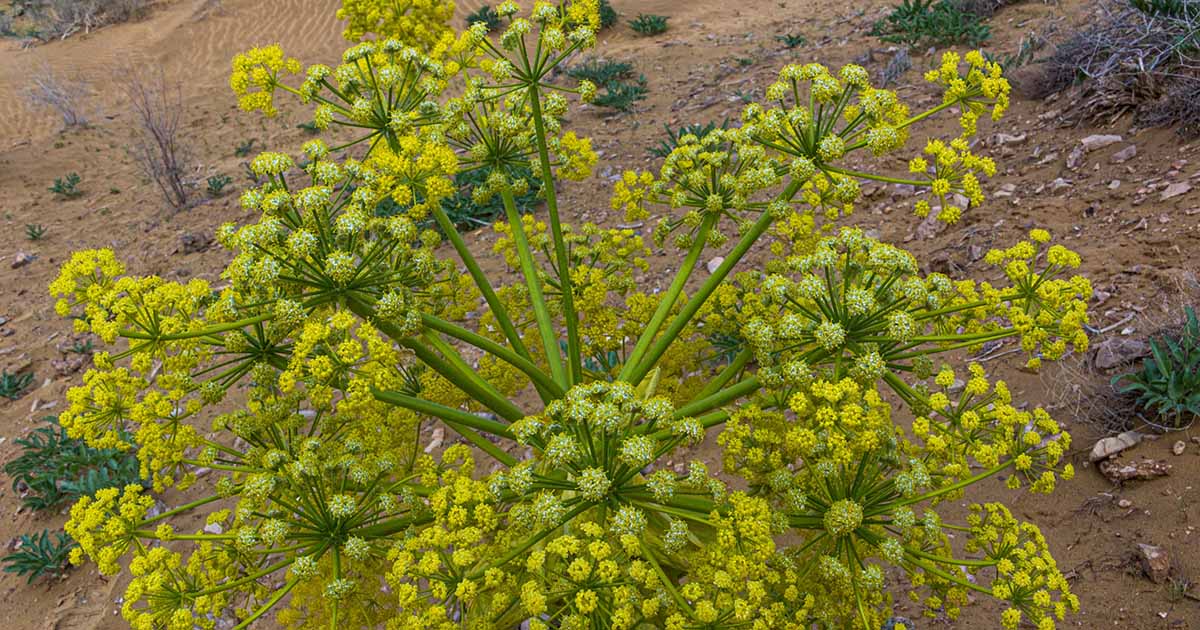
Asafoetida plant has numerous medicinal and therapeutic properties. This valuable plant is found in the heart of the desert and highlands of Central Asia and is called the gold of the desert. Asafoetida is one of the medicinal plants native to Iran. The climatic conditions in Iran have a positive effect on its physiological properties. In addition to its various medicinal properties, asafoetida has other important economic uses. The total export value of this product was 453 million and 738 thousand dollars worldwide in 2022, of which Iran had a share of 8 million and 500 thousand dollars (about 1.5 percent). Although this crop isn’t native to India and originates from Iran and Afghanistan, India is the largest exporter of this product, accounting for 16% of the total export value. Iran is the 13th exporter of asafoetida in the world, and most buyers of this gum are European countries.
Properties of Asafoetida
Asafoetida is a plant sap or gum with the English name (Asafoetida) and the scientific name (Ferula assa-foetida), which belongs to the umbel lifer family and has medicinal, edible, industrial and agricultural significance. This perennial herb grows 1 to 1.5 m high. The plant has thick and large roots, grass-like, rough and long stems, curly, large and thick leaves (which grow up to 60 cm long), yellow flowers in the form of umbrella-shaped inflorescences and its flowers change color from green to yellow and then become fruits with two seeds (dark brown or black, oval, pea- to walnut-sized and very smelly). The flowering of this plant lasts several years, but it bears fruit only once, that is, it dies after flowering. In the first years of its age, this plant has only broad leaves on the ground, and its stem isn’t visible. These leaves are called (komah) and (angzkomah) in the pastures.
If the root or the lower part of the stem of the asafoetida plant is cut off at the end of the spring season, a kind of milky gum comes out, which hardens near the air and becomes a solid mass and is called asafoetida. Asafoetida looks white and translucent at first, but darkens when exposed to air, and its color first turns pink and then brown. Asafoetida has a sharp, pungent and burning taste and an unpleasant and pungent odor reminiscent of sulfur compounds or garlic.
The plant grows in the dry and calcareous areas of warm Asia and is native to the arid deserts of Iran and the mountains of Afghanistan. Some writings mention the history of this plant in Iran during the Achaemenid and Parthian periods. Asafoetida is mentioned in medical and historical texts as one of the most commonly used medicinal plants.
Asafoetida has always attracted the attention of people and doctors due to its pungent smell, pungent taste and its unique properties such as invigorating, and the belief in the great power of this plant in warding off evil, demons, witchcraft, they had creatures such as worms and parasites. For this reason, asafoetida has always been considered one of the most expensive medicinal plants in Iran and has long been exported to most parts of the world. Asafoetida has several names. In Farsi, it is known by different names.
Asafoetida is native to Iran and Afghanistan, but is mainly used in Indian cuisine. Indians grind asafoetida into a spice form and call it hing. Asafoetida is used as a curry spice and in foods such as meatballs and pickles. Asafoetida is known in the world by the international code (HS code): 130190.
.

Benefits of Asafoetida and its nutritional value
Among the many uses of asafoetida is its use in cooking and medicine. Asafoetida has a warm and dry character and is used in traditional medicine to treat many diseases, including respiratory diseases (treatment of cough, asthma and bronchitis), colds and flu, digestive diseases (digestion, treatment of constipation), etc. In addition, asafoetida is a stimulant for the brain and can help prevent Alzheimer’s disease and brain nerve damage. In addition, this plant is useful for liver damage and inflammation of the digestive system due to its anti-inflammatory and anti-inflammatory properties.
Asafoetida contains vitamins, protein and minerals such as calcium and phosphorus, which are useful for health and strengthening the body. Also, this plant contains large amounts of phenolic compounds such as tannins and flavonoids, which are known as a good source of antioxidants that protect cells from free radical damage. These antioxidants protect cells from free radical damage and thus can prevent cardiovascular disease and cancer. In addition, asafoetida is a good protector against triglycerides and cholesterol caused by fatty foods, and by relaxing blood vessels, it lowers blood pressure. In addition, this substance can effectively lower blood sugar levels in diabetics.
Due to its antibiotic, antibacterial, antifungal, and antimicrobial properties, asafoetida can be used against pathogens such as various types of streptococcal bacteria and to treat fungal infections of the stomach.
Asafoetida plant is not only biologically undemanding, but also improves soil fertility and prevents soil erosion. From the ecological and environmental point of view, the cultivation of this plant has a high value in the prevention of soil pollution.
Species of Asafoetida
Asafoetida is commercially available in two forms: teardrop-shaped (high quality) and mass-shaped (low quality).
Teardrop type: this is one of the rarest and finest types of asafoetida. The color of the outer part of this type is yellow, reddish-yellow or dark brown, and the inner color is white or yellowish-white. First it turns purple and then reddish brown. Asafoetida is a very clean, smooth, transparent tear without dirt and debris, and its size is about that of a hazelnut or pea.
Mass type: this type of asafoetida is the most common in the trade, and is mixed with leaves and weeds due to careless collection. For this reason, it is called inferior. The taste is bitter and acrid, and the color variety of this species of asafoetida is great. Its colors are yellow, red-brown and gray-brown. In addition to the food industry, this species is also used in perfumery. The use of the essential oil of this plant affects the longevity of the plants.
Asafoetida species in Iran
In Iran, besides asafoetida, other species of the family (Ferula) grow that are similar to the asafoetida plant, and from which gum can also be obtained. Some of these species are fragrant and their flowers are white. The color of their ripe fruits is also white and their shape is round and broad (coin-shaped). There are 32 species of asafoetida in Iran, of which 15, including Koma or asafoetida of Lorestan, Binaludi and Jandaqi, are native to Iran.
.
4 other species of this plant are:
– (F.foetida): This species is found in Shahrud and Damghan (Semnan province), Sabzevar and Meyami (Khorasan Razavi province), Zarrin Dasht (Fars province) and Sistan and Baluchistan province. This species is one of the solid spices in local and traditional dishes. The height of this species is shorter than other species but it has more smell and essence.
– (F.alliacea): This species is native to Khorasan and Kerman provinces.
– (F. Kuma): Kuma plant is mainly found in the highlands of Savojbolagh, western Azerbaijan and Hamadan. This plant is known by the local name (Bioza). Its gum is as big as a bean and has a strong lemon smell.
– (F.Kurdica): this species is widely distributed in the highlands of Sarshiv district in Saqqez city of Kurdistan province, in the highlands of Avroman between the two provinces of Kurdistan and Kermanshah, and in Kohgiluyeh and Boyer-Ahmad provinces and Lorestan. Its local name is (kama) and (cattle).
.

Asafoetida growing conditions
Under natural conditions, the growth period of Asafoetida plant is about 2.5 months. The plant grows around March 15, and depending on the temperature and environmental conditions, the leaves begin to turn yellow in mid-May to early June, and finally the plant is dried by the wind and separated from the collar. Asafoetida plant usually requires care for one growing season, after which it becomes self-sufficient and the need for care decreases.
Propagation of the asafoetida plant is carried out exclusively by sowing seeds. The best time for sowing this plant is early spring and autumn. Seeds are sown in 2 ways, direct and broad-cast:
- In direct sowing, holes are dug for the seeds, then some seeds are put in, covered with a thin layer of soil and after some time the plant germinates. One of the advantages of direct seeding is that the holes store water. One of the advantages of no-till is that the holes hold water. Thus, the seeds absorb more moisture and the plant germinates and grows more easily.
- In the broad-sowing method, the seeds are scattered evenly on the surface so that the density between them is maintained. The distance between plants in both methods should be between 20 and 40 cm. Two important points that should be considered in this method are that the soil chosen for sowing should not be hard and the ambient temperature should be between 12 and 15 degrees Celsius. Also, the humidity suitable for plant growth is about 7%.
.
Suggested article: Iran export potential: export of tomato paste
Some tips for planting Asafetida
Altitude and slope of the cultivation area: the selected cultivation area should be at an altitude of more than 2000 meters and have a slope of more than 20%.
Soil: Cultivation of the asafoetida plant is suitable for pastures and most soils with a light texture (except clay), provided they have good drainage. Since the plant has long roots, the soil should not be hard and compact, and sandy, loamy soils are suitable for planting. Also, this plant is resistant to pH changes.
Temperature: asafoetida grows best in cold and humid areas, but is resistant to temperatures as low as -10 degrees Celsius. In general, the ideal temperature for the growth of this plant is 18 degrees Celsius.
Humidity and water: Asafoetida is drought tolerant and requires little water. Rainfall between 600 and 800 mm is suitable for this plant. However, when germinating, asafoetida must be moist enough to reach this water or it will fall over.
Sunlight: this plant needs full sunlight to grow. The sunny southern slopes of the highlands are suitable for better lighting of the plant.
Global trade in Asafetida
In 2021, natural gum, resin, gum resin, balsam, not gum arabic, was the 2602nd most traded product in the world, with a total trade volume of $639 million. Between 2020 and 2021, exports of natural rubber, resin, gum resin, balsam, not gum arabic increased by 18.8%, from $538 million to $639 million. Trade of natural rubber, resin, gum resin, balsam, not gum arabic accounts for 0.003% of total world trade. In 2022, the total export value of this product will be 453 million and 738 thousand dollars, which is a decrease compared to last year. The largest exporters of this product in the world are India ($73 million), Indonesia ($67 million), Brazil ($49 million), Thailand ($47 million) and Somalia ($32 million).
.

.

.

.
In 2022, the total import value of this product was 492 million and 652 thousand US dollars. India (74 million US dollars), Portugal (62 million US dollars), the United States (51 million US dollars), China (43 million US dollars), Germany (27 million US dollars) and France (20 million US dollars) are the largest importers of natural rubber and resin.
.

.

.

Asafoetida growing areas in the world
The perennial asafoetida plant has several varieties and is native to the region between the Mediterranean and Central Asia, especially Iran and Afghanistan. Besides these two countries, other habitats of this plant include Kazakhstan, Uzbekistan, Turkmenistan, Tajikistan, Pakistan, China and Russia. However, today asafoetida grows in Iran and Afghanistan, and asafoetida is exported from these two countries to other parts of the world. This plant is not native to India and was only introduced to India around 600 BC, but India is one of the largest consumers of this substance in the world. Indians have been using asafoetida in Indian medicine and cuisine for centuries.
Iran's export statistics for Asafoetida
In 2021, Iran exported natural gum, resin, gum resin, balsam, not gum arabic worth $8.51 million, making it the 14th largest exporter of natural gum, resin, gum resin, balsam, not gum arabic in the world. In the same year, natural gum, resin, gum resin, balsam, not gum arabic was the 147th most exported product in Iran. In 2022, the total value of Iran’s exports was $7.1 million, a decrease from the previous year. This amount of Iran’s exports accounts for 1.5% of the world’s exports of this product in this year and ranks 13th among the world’s exports. The average distance of importing countries is 4202 km and the concentration of exports is 0.22. Germany ($2 million), England ($1 million 400 thousand), France ($1 million 300 thousand), Switzerland ($481 thousand) and Australia ($472 thousand) are the main destinations of natural rubber and Iranian resin.
.

.

Asafoetida cultivation areas in Iran
The main cultivation area of the asafoetida plant is in the east of the country. Most of the high quality and expensive asafoetida in Iran is grown on the slopes of the Shotorī Mountains in the east of the city of Tabas and the cities of Ferdous, Qaen, and Nehbandan in South Khorasan Province, and in the Hezar Masjed Mountains in the north of the city of Dargaz, the district of Kuhsorkh, and the city of Kalat in Khorasan Province. In addition to the provinces of Khorasan, on the slopes of the Zagros Mountains and in the provinces of Kerman (city of Ravar), Isfahan (city of Nain), Sistan and Baluchistan, Kerman, Fars (city of Sarchehan, Lar, Abadeh and Dasht-e- Morghab) and in the cold regions, it also grows in the provinces of Kohgiluyeh and Boyer-Ahmad.
Some villages, including Raf village in Tarbiat Heydarieh, Angedan village in Kashan area and Anjedan village in Arak, got their name from this plant because asafoetida is grown in these areas.
Global Asafoetida Market Outlook
The asafoetida market is segmented on the basis of type (white and red asafoetida), application (edible (food and gum), medicinal, perfumery, etc.), and region. Asafoetida is used in various food and beverages such as cheese, chocolate, oatmeal cookies, cakes, dairy products, etc. In 2017, the food sector accounted for the largest share of the global market for this spice. In 2020, the APAC region accounted for the largest market share of over 58%, followed by EMEA and Americas. It is predicted that due to the increase in demand for this product as a spice in North America due to the increase in consumer awareness about the properties and benefits of this natural gum for health and the increase in consumption of Mexican food in Latin America, from 2021 to 2030, Americas will have the highest incremental growth, and then Europe will experience significant growth over the forecast period.
Demand for the product in food applications was highest in North America, followed by Europe. Asia-Pacific is expected to witness significant growth due to increasing consumption of processed food, especially in China, India, and Japan. Chewing gums were the second largest application segment, accounting for over 19% of global demand, with high consumption rates in Middle Eastern countries, including the United Arab Emirates, Saudi Arabia, Kuwait, etc., the U.S., Argentina, etc. The global Hing (asafoetida) market will witness significant growth between 2022 and 2030, with positive outlook in 2022 and beyond. With key players in the industry adopting effective strategies, the market is expected to expand further and offer numerous opportunities for advancement.
